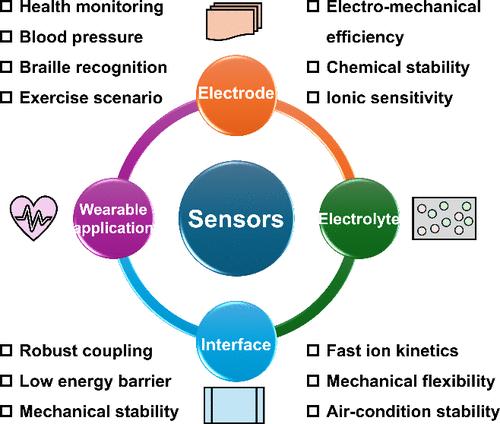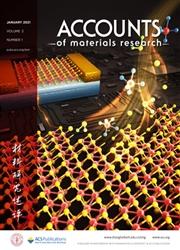Piezoionic Skin Sensors for Wearable Applications
IF 14
Q1 CHEMISTRY, MULTIDISCIPLINARY
引用次数: 0
Abstract
Piezoionic skin sensors are one kind of artificial electrical skin that can output sensing signals in response to external strain or stress stimulus with merits of flexibility, lightness, scalability, and high sensitivity. They have been emerging as an important platform in artificial intelligence, such as in smart healthcare, bionic robotics, and microelectromechanical systems. Piezoionic sensors are typically composed of an electrolyte laminated with symmetric electrodes and are based on ion migration and redistribution under a gradient strain or stress field. However, existing challenges significantly impede the sensing performance of piezoionic sensors, including the low electromechanical coupling efficiency of the electrode materials, instability of electrolyte materials, and strain-induced interface separation of sensor interfaces. In recent years, our group and collaborators have made attempts addressing the as-mentioned critical challenges in order to achieve flexible piezoionic sensors with satisfying performance for wearable smart applications. First, for the electromechanical coupling efficiency of electrode materials, we have developed various electrode materials with highly efficient ion storage and transfer, such as graphdiyne, quinone composites, and graphitic carbon nitride. These materials present superior electrical and mechanical properties with enhanced electromechanical coupling efficiency. Second, in order to improve the stability of electrolytes, especially in an air environment, we have developed ionogel electrolytes instead of conventional hydrogel electrolytes. Ionogels contain highly stable ionic liquids, which effectively improve the air stability of sensor electrolytes, and the sensing properties of devices are preserved even after several months. Third, with regard to sensor interface separation, we have engineered stable material interfaces for piezoionic sensors with elaborate structures. The as-designed tree-root-inspired interfaces show high mechanical stability under various flexible conditions, and the piezoionic sensors display negligible performance deterioration under thousands of bending cycles in an ambient environment. Finally, we have obtained flexible piezoionic sensors and studied their practical applications, such as wearable electronics, health monitoring, and smart detections. For example, we have realized the accurate detection of blood pressure based on an out-of-plane piezoionic mechanism. This innovative technique completely avoids the cuff issue that commercial sphygmomanometers have. Moreover, we have developed multifinger-touch piezoionic sensor arrays for effective braille recognition, which have the potential to eliminate communication barriers with sight-impaired people. Human voices can be easily differentiated by detecting vocal-cord vibrations based on captured sensing signals with obviously different patterns. This smart technique is promising for extended and applied use in virtual reality technology. Lastly, a perspective on existing challenges of piezoionic sensors is highlighted to set a clear direction for future research, including low-cost material synthesis, the mass production of flexible sensors, and healthcare sensor products.

用于可穿戴应用的压电皮肤传感器
压电皮肤传感器是一种能够响应外界应变或应力刺激输出传感信号的人造电皮肤,具有柔性、轻便、可扩展性和高灵敏度等优点。它们已成为智能医疗、仿生机器人和微机电系统等人工智能领域的重要平台。压电离子传感器通常由对称电极层合的电解质组成,并基于离子在梯度应变或应力场下的迁移和再分布。然而,现有的挑战严重阻碍了压电离子传感器的传感性能,包括电极材料的机电耦合效率低,电解质材料的不稳定性以及传感器界面的应变引起的界面分离。近年来,我们的团队和合作者已经尝试解决上述关键挑战,以实现可穿戴智能应用中具有令人满意性能的柔性压电传感器。首先,对于电极材料的机电耦合效率,我们开发了多种具有高效离子存储和转移的电极材料,如石墨炔、醌复合材料、石墨氮化碳等。这些材料具有优异的电气和机械性能,并具有增强的机电耦合效率。其次,为了提高电解质的稳定性,特别是在空气环境中,我们开发了离子凝胶电解质代替传统的水凝胶电解质。离子凝胶中含有高度稳定的离子液体,有效地提高了传感器电解质的空气稳定性,即使几个月后,器件的传感性能也能保持不变。第三,在传感器界面分离方面,我们设计了具有复杂结构的压电离子传感器的稳定材料界面。设计的树根界面在各种柔性条件下具有很高的机械稳定性,并且在环境环境中数千次弯曲循环下,压电离子传感器的性能下降可以忽略不计。最后,我们获得了柔性压电传感器,并研究了其实际应用,如可穿戴电子,健康监测和智能检测。例如,我们已经实现了基于面外压电机制的血压精确检测。这种创新技术完全避免了商业血压计的袖带问题。此外,我们还开发了用于有效盲文识别的多指触控压电传感器阵列,这有可能消除视障人士的沟通障碍。根据捕捉到的具有明显不同模式的传感信号,检测声带振动,可以很容易地区分人声。该智能技术在虚拟现实技术中具有广阔的应用前景。最后,强调了压电传感器存在的挑战,为未来的研究设定了明确的方向,包括低成本材料合成、柔性传感器的批量生产和医疗保健传感器产品。
本文章由计算机程序翻译,如有差异,请以英文原文为准。
求助全文
约1分钟内获得全文
求助全文

 求助内容:
求助内容: 应助结果提醒方式:
应助结果提醒方式:


